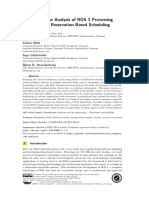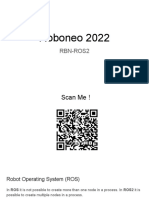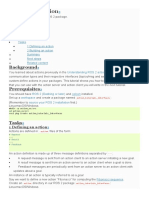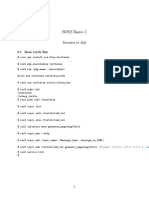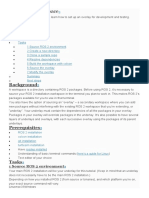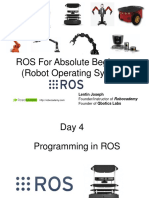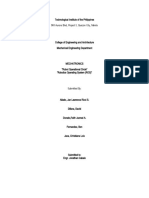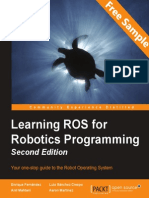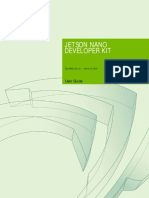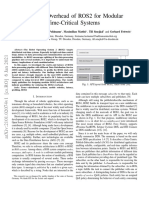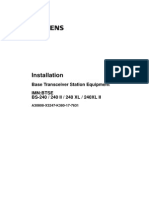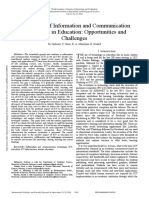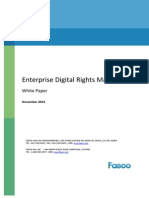Real-time control in ROS and ROS 2.
0
Jackie Kay
jackie@osrfoundation.org
Adolfo Rodriguez Tsouroukdissian
adolfo.rodriguez@pal-robotics.com
�Table of Contents
A motivating example
Real-time computing
Requirements and best practices
ROS 2 design
Comparison with ROS 1 and ros_control
Demo and results
�A motivating example
�A motivating example
�A motivating example
Blocks can be composed by other blocks
Some blocks are subject to real-time constraints
�A motivating example
Blocks can be composed by other blocks
Some blocks are subject to real-time constraints
�A motivating example
Blocks can be composed by other blocks
Some blocks are subject to real-time constraints
System topology can change at runtime
7
�A motivating example
Blocks can be composed by other blocks
Some blocks are subject to real-time constraints
System topology can change at runtime
8
�A motivating example
Blocks can be composed by other blocks
Some blocks are subject to real-time constraints
System topology can change at runtime
9
�A motivating example
Blocks can be composed by other blocks
Some blocks are subject to real-time constraints
System topology can change at runtime
10
�Table of Contents
A motivating example
Real-time computing
Requirements and best practices
ROS 2 design
Comparison with ROS 1 and ros_control
Demo and results
11
�Real-time computing
It's about determinism, not performance
Correct computation delivered at the correct time
Failure to respond is as bad as a wrong response
12
�Real-time computing
13
�Real-time computing
14
�Real-time computing
Usefulness of results after missing a deadline?
15
�Real-time computing
Hard real-time systems
Missing a deadline is considered a system failure
Overruns may lead to loss of life or financial damage
Safety- or mission-critical systems
Examples: reactor, aircraft and spacecraft control
16
�Real-time computing
Soft real-time systems
Missing a deadline has a cost, but is not catastrophic
Result becomes less useful after deadline
Often related to Quality of Service
Examples: audio / video streaming and playback
17
�Real-time computing
Firm real-time systems
Missing a deadline has a cost, but is not catastrophic
Result becomes useless after deadline
Cost might be interpreted as loss of revenue
Examples: Financial forecasting, robot assembly lines
18
�Real-time computing
Why do we care?
Event response
e.g. parts inspection
Closed-loop control
e.g. manipulator control
Added benefit: Reliability, extended uptime
Downtime is unacceptable or too expensive
The above is prevalent in robotics software
19
�Goal of ROS 2
Real-time compatibility, from day one
20
�Table of Contents
A motivating example
Real-time computing
Requirements and best practices
ROS 2 design
Comparison with ROS 1 and ros_control
Demo and results
21
�Requirements and best practices
Use an OS able to deliver the required determinism
Linux variants
OS
real-time
max latency (s)
Linux
no
104
RT PREEMPT
soft
101-102
Xenomai
hard
101
Proprietary: e.g. QNX, VxWorks
POSIX compliant, certified to IEC 61508 SIL3 et.al.
22
�Requirements and best practices
Prioritize real-time threads
Use a real-time scheduling policy
23
�Requirements and best practices
Prioritize real-time threads
Use a real-time scheduling policy
24
�Requirements and best practices
Avoid sources of non-determinism in real-time code
Memory allocation and management ( malloc, new )
Pre-allocate resources in the non real-time path
Real-time safe O(1) allocators exist
Blocking synchronization primitives (e.g. mutex)
Real-time safe alternatives exist (e.g. lock-free)
Printing, logging ( printf, cout )
Real-time safe alternatives exist
25
�Requirements and best practices
Avoid sources of non-determinism in real-time code
Network access, especially TCP/IP
RTnet stack, real-time friendly protocols like RTPS
Non real-time device drivers
Real-time drivers exist for some devices
Accessing the hard disk
Page faults
Lock address space (mlockall), pre-fault stack
26
�Table of Contents
A motivating example
Real-time computing
Requirements and best practices
ROS 2 design
Comparison with ROS 1 and ros_control
Demo and results
27
�ROS2 design - architecture comparison
usercode.cpp
usercode.py
usercode.cpp
usercode.c
usercode.py
roscpp
rospy
rclcpp
rclc
rclpy
UDPROS
TCPROS
ROS 2 Middleware API
Opensplice
FreeRTPS
etc.
28
�ROS2 design - real-time architecture
usercode.cpp
ros_control Orocos
roscpp
UDPROS
usercode.cpp
usercode.c
rclcpp
rclc
ROS 2 Middleware API
TCPROS
Real-time Operating System
Opensplice
FreeRTPS
etc.
Real-time Operating System
29
�ROS2 design Modularity
ROS2 allows customization for real-time use-cases
Memory management
Synchronization
Scheduling
are orthogonal to each other, and to node topology
30
�ROS 2 - current implementation
Executor
initialization
preallocate memory
...
spin
rmw_wait(timeout)
{
pass conditions to waitset
wait (in DDS)
wake-up if timed-out
}
do work if it came in
cleanup
deallocate memory
...
non real-time
real-time
loop until interrupted
non real-time
31
�ROS2 design Node lifecycle
Standard node lifecycle state machine
Opt-in feature
Node lifecycle can be managed without knowledge
of internals (black box)
Best practice from existing frameworks
microblx
OpenRTM
Orocos RTT
ros_control
32
�ROS2 design Node lifecycle
credit: Geoffrey Biggs et.al.
WIP, design subject to change
33
�ROS2 design Node lifecycle
credit: Geoffrey Biggs et.al.
WIP, design subject to change
34
�ROS2 design Node lifecycle
credit: Geoffrey Biggs et.al.
WIP, design subject to change
35
�ROS2 design Node lifecycle
Benefits of managed lifecycle
Clear separation of real-time code path
Greater control of ROS network
Help ensure correct launch sequence
Online node restart / replace
Better monitoring and supervision
Standard lifecycle standard tooling
36
�ROS2 design Node composition
37
�ROS2 design Node composition
Composite node is a black box with well-defined API
Lifecycle can be stepped in sync for all internal nodes
Resources can be shared for internal nodes
38
�ROS2 design Communications
Inter-process
DDS can deliver soft real-time comms
Customizable QoS, can be tuned for real-time use-case
Intra-process
Efficient (zero-copy) shared pointer transport
Same-thread
No need for synchronization primitives. Simple, fast
39
�ROS 2 alpha release
Real-time safety is configurable
Can configure custom allocation policy that
preallocates resources
Requires hard limit on number of pubs, subs, services
Requires messages to be statically sized
40
�ROS2 progress overview
In progress
Component lifecycle
Composable components
Complete intra-process pipeline
Future work
Pre-allocate dynamic messages
CI for verifying real-time constraints
Lock-free multi-threaded executor
41
�Table of Contents
A motivating example
Real-time computing
Requirements and best practices
ROS 2 design
Comparison with ROS 1 + ros_control
Demo and results
42
�Comparison with ROS1 + ros_control
Real-time safe communications
Lifecycle management
Composability
43
�Comparison with ROS1 + ros_control
Real-time safe communications
Lifecycle management
Composability
44
�Comparison with ROS1 + ros_control
ROS1 + ros_control:
ROS2 equivalent:
drop non-standard lifecycle / interfaces gentler learning curve
smaller codebase
easier to maintain
45
�Table of Contents
A motivating example
Real-time computing
Requirements and best practices
ROS 2 design
Comparison with ROS 1 and ros_control
Demo and results
46
�ROS 2 Real-time Benchmarking: Setup
real-time process
motor command
controller
simulator
sensor feedback
user command
teleop
non real-time process
profiling results
logger
non real-time process
47
�ROS 2 Real-time Benchmarking: Setup
Configuration
RT_PREEMPT kernel
Round robin scheduler (SCHED_RR), thread priority: 98
malloc_hook: control malloc calls
getrusage: count pagefaults
Goal
1 kHz update loop (1 ms period)
Less than 3% jitter (30 s)
Code
ros2/demos - pendulum_control
48
�ROS 2 Real-time Benchmarking: Memory
Zero runtime allocations
static void * testing_malloc( size_t size, const void * caller) {
if (running) {
throw std::runtime_error("Called malloc from real-time context!" );
}
// ... allocate and return pointer...
}
Zero major pagefaults during runtime
Some minor pagefaults on the first iteration of the loop, none after
Conclusion: all required pages allocated before execution starts
49
�ROS 2 Real-time Benchmarking: Results
Latency (ns)
% of update rate
Min
1620
0.16%
Max
35094
3.51%
Mean
4567
0.46%
No stress
1,070,650 cycles observed
Timeseries
Jitter histogram
50
�ROS 2 Real-time Benchmarking: Results
Latency (ns)
Stress applied:
stress --cpu 2 --io 2
7,345,125 cycles observed
3 instances of overrun observed
% of update rate
Min
1398
0.14%
Max
258064
25.8%
Mean
3729.11
0.38%
Jitter histogram
51
�Closing remarks
Systems subject to real-time constraints are very
relevant in robotics
ROS2 will allow user to implement such systems
with a proper RTOS, and carefully written user code
Initial results based on ROS2 alpha are encouraging
inverted pendulum demo
Design discussions and development are ongoing!
ROS SIG Next-Generation ROS
ros2 Github organization
52
�Selected references
[Biggs, G.] ROS2 design article on node lifecycle (under review)
[Bruyninckx, H.] Real Time and Embedded Guide
[Kay, J.] ROS2 design article on Real-time programming
[National Instruments] What is a Real-Time Operating System (RTOS)?
[OMG] OMG RTC Specification
[ROS Control] ROS Control, an Overview
[RTT] Orocos RTT component builder's manual
[RT PREEMPT] Real-Time Linux Wiki
[Xenomai] Xenomai knowledge base
53

